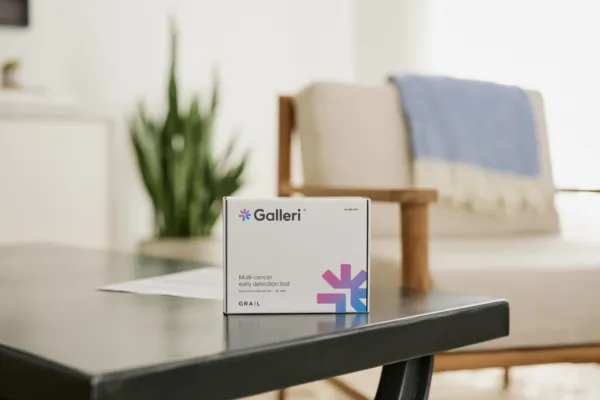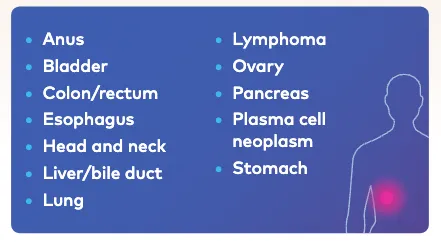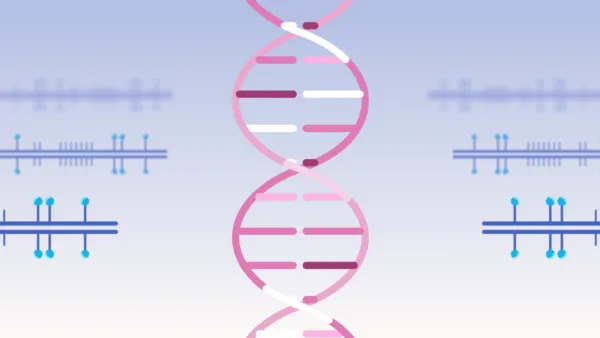TRICARE beneficiaries, please speak with your healthcare provider to request the Galleri test as a covered benefit. GRAIL's independent telemedicine provider is not currently authorized by TRICARE for Galleri test requests.
Take control when it comes to cancer. The Galleri test helps you be proactive about your health.1
The Galleri test does not detect a signal for all cancers and not all cancers can be detected in the blood. False positive and false negative results do occur. The Galleri test should be used in addition to cancer screening tests your healthcare provider recommends. Galleri is by prescription only.

The Galleri test does not detect a signal for all cancers and not all cancers can be detected in the blood. False positive and false negative results do occur. The Galleri test should be used in addition to cancer screening tests your healthcare provider recommends. Galleri is by prescription only.
Galleri is a screening test that looks for cancer before symptoms appear, when cancer may be easier to treat. It is important to get cancer screenings even if you feel fine.
12 of the deadliest cancers are responsible for two-thirds of cancer deaths. These cancers tend to release more DNA fragments into the bloodstream at early stages.
The Galleri test screens for many of these deadly cancers that have no recommended screening tests.
The Galleri test sensitivity for these cancers varies across cancer types and stages.

Cancers growing in the body shed DNA into the bloodstream.1,2,3 Although there are many types of cancer, the DNA fragments can act like a unique “fingerprint” of cancer. This Galleri test screens for many of the deadliest cancers before they become symptomatic,4 including many without recommended screening tests.1,5 The Galleri test results provide direction to your healthcare provider and help guide the next steps for diagnosis.4
Galleri is a screening test and does not diagnose cancer. Diagnostic testing is needed to confirm cancer.

The Galleri test is available by prescription only.
The guide provides helpful information and instructions for your provider to order the test if they determine it's right for you.
Your test must be ordered by a healthcare provider AND blood draw completed by April 18, 2025, to receive $100 off.*
Request the test online through an independent telemedicine provider. Enter the Galleri Key to receive $100 off*: GC2025
Your test must be ordered by April 18, 2025, to receive $100 off.*
This offer is available through your provider or tests can be requested online at Galleri.com through an independent telemedicine provider. Eligibility will be assessed at the time of your test request.
The discount only applies to full-priced, self-pay tests priced at $949. Most health insurance plans do not cover the Galleri test.
*Limited time offer valid only for Galleri test orders placed March 18, 2025, midnight PST through the applicable Offer End Date (defined below). Valid only for Galleri test orders requested online and approved by the GRAIL-contracted independent telemedicine provider (“Telemedicine Order”) or by your independent healthcare provider using the GRAIL-provided Test Requisition Form specifically for this offer (“Clinic Order”). The “Offer End Date” means: (i) for Telemedicine Orders, April 18, 2025, 11:59 pm PST; (ii) for Clinic Orders, April 18, 2025, 11:59 pm PST. Valid for Clinic Orders only if the blood draw for the Galleri test is completed by the applicable Offer End Date. Offer does not confirm your eligibility for the Galleri test. Valid only for one-time use on domestic US Galleri test orders only. Offer valid only for a discount off the Galleri test list price ($949). Offer cannot be: (1) combined or used with any other discount, promotion, special pricing, or payment plan; (2) used to request a credit on a test order placed prior to the offer period; or (3) posted online or on any other publicly available forum. GRAIL reserves the right to change the terms and conditions, substitute an offer of equal or greater value, and end the offer at any time without notice. For Galleri test orders requested online, you must create an account to redeem this offer and enter the code at the “Introduction” stage, where prompted.
You will receive your test result about two weeks after your blood sample is received at the GRAIL lab.
There are two possible results:
Nearly 99% of people who use the Galleri test, will screen negative — which is exactly what you want to hear.4 Continue with routine cancer screening tests your healthcare provider recommends.
If a cancer signal is found, results can predict the tissue type or organ associated with the cancer signal and help your healthcare provider guide the next steps.4
The Galleri test does not detect a signal for all cancers and not all cancers can be detected in the blood. False positive and false negative results do occur.

The Galleri test is recommended for use in adults with an elevated risk for cancer, such as those age 50 or older. The test does not detect all cancers and should be used in addition to routine cancer screening tests recommended by a healthcare provider. The Galleri test is intended to detect cancer signals and predict where in the body the cancer signal is located. Use of the test is not recommended in individuals who are pregnant, 21 years old or younger, or undergoing active cancer treatment.
Results should be interpreted by a healthcare provider in the context of medical history, clinical signs, and symptoms. A test result of No Cancer Signal Detected does not rule out cancer. A test result of Cancer Signal Detected requires confirmatory diagnostic evaluation by medically established procedures (e.g., imaging) to confirm cancer.
If cancer is not confirmed with further testing, it could mean that cancer is not present or testing was insufficient to detect cancer, including due to the cancer being located in a different part of the body. False positive (a cancer signal detected when cancer is not present) and false negative (a cancer signal not detected when cancer is present) test results do occur. Rx only.
The GRAIL clinical laboratory is certified under the Clinical Laboratory Improvement Amendments of 1988 (CLIA) and accredited by the College of American Pathologists. The Galleri test was developed — and its performance characteristics were determined — by GRAIL. The Galleri test has not been cleared or approved by the Food and Drug Administration. The GRAIL clinical laboratory is regulated under CLIA to perform high-complexity testing. The Galleri test is intended for clinical purposes.
Klein EA, Richards D, Cohn A, et al. Clinical validation of a targeted methylation-based multi-cancer early detection test using an independent validation set. Ann Oncol. 2021 Sep;32(9):1167-77. doi: 10.1016/j.annonc.2021.05.806
Liu MC, Oxnard GR, Klein EA, et al. Sensitive and specific multi-cancer detection and localization using methylation signatures in cell-free DNA. Ann Oncol. 2020 Mar 30;31(6):745-59. doi: 10.1016/j.annonc.2020.02.011
Thierry AR, El Messaoudi S, Gahan PB, et al. Origins, structures, and functions of circulating DNA in oncology. Cancer Metastasis Rev. 2016 Jul 8;35:347–76. doi: 10.1007/s10555-016-9629-x
Schrag D, Beer TM, McDonnell CH, et al. Blood-based tests for multi-cancer early detection (PATHFINDER): a prospective cohort study. Lancet. 2023;402:1251-1260. doi: 10.1016/S0140-6736(23)01700-2
US Preventive Services Task Force. A,B,C grade recommendations, cancer, screenings. [cited 2023 Oct 23]. https://www.uspreventiveservicestaskforce.org/uspstf/topic_search_results